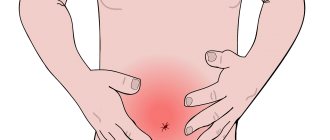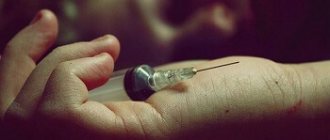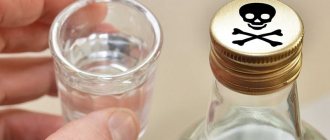A drug called Furazolidone is a drug that is most useful for food poisoning. It should also be noted that such a medicine is extremely effective in treating a number of other potential diseases. Quite often this drug is used in pediatric practice. This is justified by the fact that the auxiliary components of the drug called Furazolidone have a gentle effect on the weakened body of children.
Release form, composition and packaging
◊ Tablets of yellow or greenish-yellow color, flat-cylindrical, with a bevel.
| 1 tab. | |
| furazolidone | 50 mg |
Excipients: potato starch - 20 mg, calcium stearate (calcium stearate) - 1 mg, sugar (sucrose) - 10 mg, Tween-80 (polysorbate) - 0.2 mg, lactose (milk sugar) - 18.8 mg.
10 pieces. — cellless contour packages. 10 pieces. — contour cellular packaging (2) — cardboard packs. 10 pieces. — contour cellular packaging (3) — cardboard packs. 10 pieces. — contour cellular packaging (4) — cardboard packs. 10 pieces. — contour cellular packaging (5) — cardboard packs. 50 pcs. — polymer jars (1) — cardboard packs.
To prevent neuritis with long-term use, it must be combined with B vitamins.
Application in veterinary medicine
The veterinary drug is a yellow powder, insoluble in water.
The drug is used for salmonellosis , coccidiosis , colibacillosis , enteritis , balantidiasis in animals and birds. You can also use a pharmaceutical drug in tablets (one tablet contains 50 mg).
The dosage for these diseases is the same for chickens, turkey poults and broilers - the drug is added to the feed at the rate of 3 mg per head 2 times a day, treatment is carried out for 8 days. If necessary, the course of treatment is repeated, but after a break of 10 days. As a preventative measure, young animals up to 10 days of age are given 2 mg per head once a day.
An overdose is unacceptable, since the bird becomes drowsy, lethargic and may die. How to feed to chickens? Better with food. Another option is to dissolve it in water and give it as a drink. But you need to know that the drug does not dissolve well and loses its properties when exposed to sunlight.
Reviews about Furazolidone
The question is often asked about this drug: is it an antibiotic or not? This is not an antibiotic , but a synthetic antibacterial agent , which differs from true antibiotics in the mechanism of action on microorganisms and the effect on the human body.
What are Furazolidone tablets for? only for diarrhea ? Intestinal infections are the main indication for the use of the drug. In addition to Furazolidone, other intestinal antiseptics ( Nifuroxazide , Rifaximin ) can be prescribed to correct microflora, followed by the use of probiotics .
Furazolidone tablets in combination with sorbents and Creon are prescribed for the treatment of giardiasis . There are reviews about this very often. In this case, reviews of Furazolidone are mostly negative, since even a 10-day course did not lead to eradication of the parasite. Metronidazole or Macmiror are more effective than furazolidone. What else does this drug help with? For urinary system infections, it is prescribed for 7-14 days.
There are other indications for the use of Furazolidone, which the abstract does not indicate. For example, anti-Helicobacter therapy , including Furazolidone, is effective in the treatment of erosive and ulcerative diseases in adults. The same treatment regimen is used for children infected with Hilicobacter pylori (HP) . It includes De-nol , Furazolidone, Amoxicillin , Ranitidine and after treatment, 100% eradication of HP is achieved.
Reviews often indicate side effects of the drug - nausea and sometimes vomiting. When taking the drug without a doctor's prescription, carefully study all contraindications and follow the recommended doses.
Furazolidone for children
The instructions for children provide the following indications for use: amoebic dysentery , salmonellosis , giardiasis .
Pharmacokinetics
Well absorbed when taken orally. Distributed in tissues and liquids. In the cerebrospinal fluid during meningitis , the same concentrations are created as in the plasma; therapeutic concentrations are also achieved in the intestinal lumen. Intensively metabolized in the liver to an inactive metabolite. Excreted by the kidneys (up to 65%), small amounts are determined in feces,
Antidepressants , Phenylephrine , Ephedrine , MAO inhibitors , Tyramine , Amphetamine in combination with furadonine cause a significant increase in blood pressure.
Does Furazolidone help with diarrhea?
It is not recommended to use the medication together with antidepressants, since simultaneous use causes an increase in blood pressure. When taken simultaneously with alcohol, teturam-like reactions develop, which can lead to coma. The drug enhances the effect of tetracycline and aminoglycosides (kanamycin, gentamicin). Furazolidone allows you to fight the following ailments:
- typhoid fever;
- dysentery;
- paratyphoid fever;
- giardiasis;
- food poisoning;
- salmonellosis.
In most cases, the drug is not addictive. Indications for use:
- disorder due to infection of various parts of the intestine. The drug quickly neutralizes loose stools. In this case, treatment is supplemented with sorbents;
- prevention against lamblia.
In the process of disorders of the gastrointestinal tract, a person may suffer from nausea, weakness, and high body temperature. In some cases, severe dizziness is even possible. Before starting treatment with this medication, be sure to consult with a qualified physician.
- Nausea and vomiting.
- Decreased appetite.
- Allergic reactions manifest themselves in the form of rashes and itching.
- With long-term use - polyneuritis.
- Increasing intensity of urine color with a change in color: from pink to dark brown.
- Palpitations, sweating, increased body temperature, feeling hot and anxious - after drinking alcohol during treatment.
We recommend reading: Paracetamol and hangover - a dangerous combination
To avoid side effects, it is recommended to take Furazolidone before meals with a sufficient amount of liquid. If serious side effects occur, call a medical team at home.
Combination of drugs
Has an inhibitory effect on monoamine oxidase. It is not recommended to combine with the following groups of drugs:
- hypoglycemic;
- weight loss drugs;
- herbal antidepressants;
- hypotensive;
- diuretics;
- beta blockers.
You should avoid these medications at the time of taking Furazolidone. The simultaneous use of Chloramphenicol promotes increased inhibition of hematopoiesis. A similar effect is observed when using Ristomycin.
When combined with aminoglycosides, the antibacterial effect is enhanced.
Simultaneous consumption of alcohol can provoke toxic hepatitis. In persons taking Furazolidone, sensitization to ethanol increases.
How quickly does the medicine work?
The main advantage of the drug is rapid absorption into the tissues of the digestive tract. The highest concentration of the active substance is observed already in the first half hour after administration and remains in the child’s blood for 5-6 hours or longer, depending on the individual characteristics of the body.
The body does not absorb Furazolidone. A minimal amount of the active substance (only 5%) enters the systemic bloodstream, but is soon eliminated naturally - through the urinary system. After use, after some time, the urine turns bright yellow or brown.
In order not to disrupt the absorption rate and therapeutic effect of the drug, you need to know that it cannot be used simultaneously with antitussive drugs. If a child is being treated with any internal or external medicinal substances, be sure to inform the doctor.
Interaction
During therapy with Furazolidone, it is necessary to avoid the use of drugs that contain ethyl alcohol, as they increase the likelihood of toxic damage to the liver and the development of severe adverse reactions from the central nervous system.
The drug should not be used together with antacids, magnesium, aluminum and iron preparations. Such an interaction can lead to a decrease in the absorption of Furazolidone and a decrease in its therapeutic effect.
When using Furazolidone together with Tetracycline, the antimicrobial effect of both medications is enhanced, which is important to take into account and, if necessary, reduce the dosage.
Analogs
| Name | Description | Contraindications | Cost, rub |
| Synacthen Depot | Used for intestinal disorders and toxic poisoning. | Not recommended for patients with diseases of the duodenum. | From 2450 |
| Befungin | Used for the development of peptic ulcers and poisoning. | Not recommended for hypersensitive people. | From 172 |
| Ofor | It is an antibacterial, antiprotozoal drug. | Not recommended for children under 18 years of age, pregnant or lactating girls. | From 148 |
| Negroes | It is an effective antibacterial agent belonging to the quinolone subgroup. | Not recommended for hypersensitive patients. | From 250 |
| Bi-tol | It is an antimicrobial agent. | Not recommended for people with impaired renal function and hypersensitive patients. | From 500 |
Enterofuril is considered the best replacement for Furazolidone. This drug has a pronounced antiparasitic and antiseptic effect. They differ in the mechanism of treatment and pharmacological effect. Enterofuril perfectly fights many intestinal parasites.
We recommend reading: Can worms cause allergies? What will the symptoms be? How to cure?
Nifuroxazide is also a good analogue of Furazolidone, but is not capable of destroying some strains of Proteus. The drug is characterized by low toxicity, which allows it to be taken as a prophylaxis.
Ersefuril is included in a number of medications that are the most effective means for combating bacterial diarrhea. The medicine is taken for a week.
In most cases, the drug is not addictive. Indications for use:
Overdose
Exceeding the dose of the drug prescribed by the instructions can provoke a toxic attack on the liver, the occurrence of acute toxic hepatitis, polyneuritis and toxic blood poisoning. An antidote to furazolidone has not been invented to date. In case of overdose, you should immediately rinse the patient’s stomach and give a saline or enterosorbent laxative. In case of severe diarrhea or vomiting, causing significant fluid loss, the victim is provided with plenty of fluids or special solutions to maintain optimal levels of water and electrolyte balance. Additionally, you need to take anti-allergy medications and B vitamins. An overdose in a person with kidney pathologies requires hemodialysis.
Indications, contraindications, side effects
The instructions for use for children indicate the following pathological conditions for which Furazolidone will be an effective remedy:
- Food poisoning in the acute phase caused by bacterial flora;
- inflammatory lesions of the mucous membranes of the gastrointestinal tract (gastroenteritis), caused by infectious flora and accompanied by diarrhea and vomiting;
- acute dysentery caused by protozoa (amoebas);
- salmonellosis;
- helminthic infestation in the acute stage, in particular giardiasis;
- rotavirus infection;
- typhoid fever and paratyphoid fever of unknown origin;
- extensive thermal lesions of the skin (burns), complicated by infection.
The list of indications for the use of Furazolidone in children is quite extensive. But it should be remembered that diarrhea and other symptoms of indigestion in children can be caused by completely different reasons. That is why the use of any medications, including this one, requires consultation with a specialist in order to avoid complications and side effects from treatment.
Instructions for use for children (as well as for adults) provide the following contraindications:
- Individual intolerance to any component of the drug;
- serious pathologies of the liver and kidneys, both acute and chronic;
- congenital enzyme deficiency;
- children under one month of age.
Before giving Furazolidone to children, parents should not only read the instructions for children, but also take into account the advice of the pediatrician. After all, the drug has a number of side effects. But they often develop when the dosage is exceeded, contraindications are not taken into account, or use is not intended.
- Nausea and vomiting may occur regardless of food intake.
- Lack of appetite, which will continue while taking the drug and for some time after stopping.
- Increased diarrhea, if taken specifically for this symptom. Or the appearance of loose stools if the drug is taken in connection with other pathological conditions.
- General weakness and apathy, decreased physical activity in the child, drowsiness, headaches, moodiness.
- Allergic manifestations in the form of a rash with itching, redness of the skin. Sometimes angioedema or anaphylactic shock may develop.
If any of these signs appear, you must immediately seek medical help and call an ambulance. Before doctors arrive, perform gastric lavage by inducing vomiting.
Symptoms, signs and treatment of dysentery in adults
Have you been trying to get rid of PARASITES for many years?
Head of the Institute: “You will be amazed at how easy it is to get rid of parasites by taking every day...
Read more "
Treatment of dysentery in adults takes a long time. It is necessary not only to cope with the source of inflammation, but also to restore the impaired functions of the gastrointestinal tract. Symptoms of the disease begin to rapidly gain momentum and worsen the patient’s condition every day.
general characteristics
Dysentery (shigellosis) is caused by bacteria of the genus Shigella, which affect the mucous surface of the large intestine. In the course of their life, they release toxins that negatively affect all internal human organs. The nervous system, kidneys, liver and entire intestines suffer the most. Diagnosis code according to the International Classification of Diseases (ICD 10) A03.
There are acute and chronic dysentery, each of these forms has its own characteristics.
Acute dysentery is often diagnosed for the first time and is manifested by a sharp deterioration of the condition and clear signs. There is a gastroenteric type of acute form of the disease, when the stomach and small intestine are affected. With gastroenterocolitic form, all internal organs are affected. The colitic type affects only the large intestine.
The chronic stage develops against the background of an untreated acute form or in cases where treatment was carried out incorrectly. As a result, immunity decreases, and the functions of the digestive system are not fully restored. Symptoms are mild.
How can you get dysentery? The source of infection is an infected person. There are several ways of contracting dysentery:
- Dysentery is often contracted through household contact (unwashed hands, dirty laundry, food). Grigoriev-Shiga dysentery is transmitted in this way;
- Shigella Flexnera is the most commonly transmitted species by water. Dysentery can be caused by swimming in open water, drinking unboiled tap water or well water;
- the food route is open to Shigella sonne. The causes of dysentery may be associated with eating expired foods, poorly washed fruits, vegetables, berries or herbs.
The main route of transmission of dysentery is through eating dairy products that have not been properly examined, swimming in prohibited bodies of water, and eating fruits and vegetables from the ground.
Shigella is quite resistant to unfavorable environmental conditions. They can continue to live outside the human body for up to several weeks in water, soil, and cold. They die under the influence of disinfectants, sunlight and when heated to 60 degrees.
Bacterial dysentery most often occurs in the warm season, in summer or autumn. The weather at this time of year is most favorable for the development and reproduction of bacteria.
External signs
The following stages of dysentery can be distinguished: incubation period, peak of the disease, stage of decreasing intensity of symptoms and complete recovery.
The initial stage of the disease is associated with an incubation period, which can last from several hours to 7 days. It all depends on how many bacteria have entered the body.
The peak of the disease is associated with acute manifestations and deterioration of the condition. Flexner's dysentery is the most difficult to tolerate. Recovery occurs by the end of the second week, but subject to proper treatment. Complete recovery of the body can take up to 2 months. Even after the condition improves, the person remains a carrier of the infection.
The main symptoms of dysentery are the following:
- a rise in body temperature to high levels (above 39 degrees), the body feels hot and chilly;
- a person complains of weakness, weakness;
- pain in the head, left side of the abdomen;
- in most cases, blood pressure decreases;
- heart rhythm is disturbed.
The first signs of dysentery look like this:
- an adult patient has a frequent urge to defecate, which is accompanied by severe abdominal pain;
- during illness, dry mouth is felt;
- presence of attacks of false urge to defecate;
- no appetite;
- nausea leading to vomiting.
The nature of stool in dysentery varies depending on the stage of the disease. The stool becomes thinner as it approaches the acute period. The color of the stool is greenish interspersed with blood and mucus. The frequency of loose stools reaches 17 times per day.
Symptoms of chronic dysentery during exacerbation are characterized by frequent loose stools. The stool contains greens, mucus, and foam. A person loses weight and looks exhausted. With chronic dysentery, a person becomes infectious only during an exacerbation.
Dysentery during pregnancy leads to serious complications. The pathology is dangerous for both the woman and the fetus. The risk of premature birth or miscarriage increases due to increased contraction of uterine tone. The woman experiences an increase in temperature, severe weakness, constant nausea, and repeated vomiting.
How does the infection spread to the child? The baby can become infected during childbirth, there is a high risk of intrauterine infection of the fetus, so treatment is carried out only within the walls of a hospital using gentle medications.
Protozoa cause infection
Amoebic dysentery is always caused by the simplest single-celled bacteria - amoebas. How is amoebiasis transmitted? The main source of infection is a sick person. How else can the infection be transmitted? You can also catch it through unwashed vegetables, fruits or dirty water. Flies and cockroaches can become carriers of the disease.
Ulcerative lesions develop in the walls of the large intestine. Then, from the intestine, the amoeba penetrates the blood vessels and affects neighboring internal organs.
In order to recognize the disease in time, you need to know what symptoms characterize it. The incubation period for dysentery disease can range from one week to three months. The disease develops gradually, accompanied by weakness, decreased performance, pain in the head and left side of the abdomen.
The body temperature may increase slightly, but lasts for several days, and a white coating is noted on the tongue. Sleep deteriorates and appetite decreases.
You will be surprised how many parasites will come out if you drink a glass of regular...
Parasites will leave the body in 3 days! You just need to drink on an empty stomach...
Then the symptoms may intensify. Abdominal pain is sharp, paroxysmal in nature. Frequent, loose stools up to 15 times a day bother me. There is mucus and blood in the excrement. The main color of stool is swamp green. The stomach is drawn in and rumbling is heard.
Amoebic dysentery leads to complications, most often when treatment is started late. Complications of dysentery may appear in the form of liver abscess, paraproctitis, peritonitis, and intestinal bleeding. All these conditions can lead to anemia, dystrophy or even death.
Diagnosis and differentiation
An examination is necessary to clarify the diagnosis in order to prescribe adequate treatment in the future. It is also necessary to exclude other serious diseases that have similar symptoms: amoebiasis, salmonellosis, intestinal colitis, hemorrhoids, oncology.
For example, with typhoid fever there are similar manifestations, but an additional rash appears on the body. With cholera, there is no false urge to defecate, and whitish mucus is found in the stool. With simple poisoning from low-quality products, there is no severe abdominal pain and no false urge to defecate.
Microbiological diagnosis of dysentery is the main method of studying the stool of a sick person. After taking the biomaterial, sowing should be done as early as possible. If dysentery bacilli are present, this method allows you to clarify their type and susceptibility to antibiotics.
The doctor carefully examines the patient's complaints. During the examination, the skin is examined for the presence of a rash. For a complete picture, laboratory diagnosis of dysentery is necessary. Data from a biochemical blood test, general blood test, urine and feces will be required. The patient will need to have an ultrasound of the abdominal cavity, which will show which organs are involved in the pathological process.
To obtain reliable results, a stool test for dysentery must be collected correctly. How to donate stool? The collection of biomaterial should be carried out before starting medication; only fresh stools are examined.
Blood is donated for testing using ELISA and PCR. Additional research methods are coprogram and sigmoidoscopy.
It is imperative to conduct a test for dysentery to determine the sensitivity of bacteria to certain antibiotics. For this purpose, feces or vomit are studied in the laboratory.
Correct treatment
How to treat dysentery depends on the patient's condition and the presence of complications. Treatment depends on the symptoms of dysentery in adults, which can be carried out at home or in a hospital.
Dysentery, like all other infectious diseases, poses a danger to other healthy people, so the main condition is that the sick person must be urgently isolated, since the transmission route for dysentery is domestic. Often all family members get sick.
During the period of acute dysentery, the patient must be provided with complete rest. Drinking plenty of warm fluids will help flush out toxins faster. It is recommended to drink decoctions based on chamomile, raisins, and rice:
- To restore the water-salt balance, drinking saline solutions is recommended. For this purpose, Regidron, Oralit, Glucosolan are prescribed.
- Treatment of dysentery is often accompanied by antibiotics: Ampicillin, Tetracycline, Polymyxin. Drugs from the nitrofuran group, for example Furazolidone, may be prescribed.
- To restore peristalsis and intestinal microflora, prebiotics and probiotics will be required: Linex, Baktisubtil.
- Treatment of dysentery symptoms is carried out in parallel with the intake of absorbents and enterosorbents. They allow you to quickly cope with toxins that bacteria release: Polysorb, Enterosgel, Smectin.
- How to treat pain syndrome? Antispasmodics, for example, Papaverine, will help relieve spasms and pain.
- Enzyme preparations: Festal, Creon, Mezim, Pancreatin.
- Immunomodulators and vitamin-mineral complexes will help increase the body's defenses.
You can use traditional medicine recipes, but only in combination with prescribed medications. The most effective and common recipes include ingredients such as onions, garlic, burdock juice, grapes and cherries, and propolis.
A special gentle diet is indicated throughout the entire period of treatment and recovery. All dishes must be ground. This will reduce the load on the digestive organs.
With a timely, comprehensive treatment approach, the disease can be quickly cured and the prognosis is favorable. In some cases, the consequences of dysentery appear in the form of dysbacteriosis, colitis, gastritis.
Preventive actions
The main point of prevention is compliance with sanitary and hygienic rules. Be sure to wash your hands with soap before eating, especially outdoors and after going outside.
Disease prevention measures involve being vigilant when purchasing food: you need to check expiration dates. Wash vegetables, fruits, herbs thoroughly with running water, pouring boiling water over them.
Prevention of dysentery also includes the fight against insects, which very often become carriers of infections. Flies should not be allowed to appear in the house.
Furazolidone as it is
Furazolidone is a drug from the nitrofuran group. These drugs destroy the cells of pathogenic bacteria that have entered the human body. The product acts on both anaerobic (to a greater extent) and aerobic (slightly less) pathogenic infections, gram-positive and gram-negative.
Furazolidone can be used for children only after a doctor’s prescription, as it has a fairly wide list of contraindications and side effects. However, the effect of the drug is such that it is difficult to find analogues.
Furazolidone is available in several pharmacological forms:
- tablets Furazolidone 50;
- granules used to prepare the suspension;
- white or yellow powder (it is rarely used in the treatment of humans, more often in veterinary medicine).
The active substance is furazolidone, one tablet contains 50 mg. The drug also contains auxiliary components that have a special effect on the cause of the pathology, but can cause contraindications.
You can buy the drug at a pharmacy without a prescription, but before use you should consult a specialist to avoid unwanted reactions.
For children, Furazolidone is usually prescribed in the form of a suspension, which is prepared from granules by dissolving them in warm water. Be sure to take the product with a sufficient amount of liquid.
Furazolidone, as an antibacterial synthetic drug, does not have such a pronounced effect as an antibiotic, but there are many fewer side effects. It does not have a depressing effect on the immune system; on the contrary, it acts as an immunostimulant.
Parents of small children have a lot of reasons for both immense joy and anxiety. One of the reasons that may cause concern is diarrhea in a child. Fortunately, pharmacy counters are full of drugs for such an unpleasant phenomenon. But the child’s body is so imperfect due to the fact that it is just beginning to adapt to the environment.
The digestive system is susceptible to pathogenic microorganisms such as salmonella, shigella, rotavirus and many others. They contribute to diarrhea, abdominal pain, vomiting and no less nasty troubles. It is Furazolidone that gives good results for diarrhea, but the drug is not at all easy. Let's study it more thoroughly.
And the main question is whether Furazolidone can be given to children, and how justified its use is.
Where can I buy?
You can purchase it at online pharmacy 36/6.
Practitioner. She graduated with honors from Vitebsk State Medical University in 2012 with a degree in general medicine. She was awarded a certificate of honor for her achievements in her work.
Small yellow tablets in standard packages are familiar to many from childhood. Furazolidone for diarrhea has been and remains an effective remedy for adults and children. But what else will Furazolidone save you from? As it turned out, not only from stool disorders expressed in diarrhea.
In complex therapy, the drug is successfully used to treat many ailments. And the whole point is in its unique properties, which help cope with infections that enter the body from the outside. Well, let's get acquainted again with the already known medicine.
Reception algorithm
How to take Furazolidone for children under one year of age should be decided exclusively by the pediatrician, based on objective indicators of the baby’s condition, the cause of the pathology and the presence of concomitant diseases.
The standard dosage regimen provides a dosage of 10 mg. per kilogram of the child's body weight. This is fundamentally important to avoid overdose. Its symptoms are similar to adverse reactions and require immediate symptomatic treatment, since simply stopping the drug will not relieve intoxication from the medication itself.
A child can be given Furazolidone for diarrhea according to the following scheme:
- Infants older than one month – 10 mg/kg body weight. The received dose is divided into 3-4 doses. Use granules to prepare a suspension and prepare a fresh portion each time;
- children one year of age and older - the same concentration taking into account body weight, the portion is also divided into 3-4 times and the medicine is given at approximately equal intervals;
- Children over 5 years of age are prescribed ? or 1 tablet three times a day, depending on the severity of the disease.
The duration of the course should not exceed ten days. If no visible results are observed within 2-4 days of furazolidone therapy, you should consult your doctor to prescribe another drug or dose adjustment.
We recommend reading: Polysorb for vomiting in children: instructions, will it help?
Feedback from parents is positive, whose children got rid of problems with the help of this particular medicine. It is noted that the drug causes virtually no side effects, with the exception of drowsiness and decreased physical activity.
But based on the same reviews, we can conclude that drowsiness and lethargy could be a consequence of the pathology itself, and not of taking the drug.
So, dear parents, share the information on social networks with your colleagues. But remember that treating a child without consulting a doctor can be dangerous and unpredictable.
A child can be given Furazolidone for diarrhea according to the following scheme:
1How to alleviate the baby’s condition before the doctors arrive?
First aid for vomiting involves several important rules:
- It is forbidden to leave a child alone if he has frequent vomiting.
- When vomiting, there is a risk of vomit entering the respiratory tract. This may cause asphyxia. In order not to endanger the baby’s life, you need to turn him on his side and put him in the bed semi-vertically.
- After each attack of vomiting, experts advise wiping the baby’s mouth well with clean water. These manipulations will help avoid irritation on the skin. It is very convenient to rinse your mouth with a syringe without a needle.
- Before the doctors arrive, you need to make sure that the baby is in bed. Physical activity can only make the situation worse.
- You should not give your child any strong medications on your own. Quite often, parents themselves are to blame for the deterioration of their children’s condition. Incorrectly chosen medications can harm the baby.
- If there are blood impurities in the vomit, then the baby must be put to bed and an ice pack placed on his stomach. You can also let your baby swallow a piece of ice. The cold will constrict the blood vessels and stop bleeding. If there are drops of blood in the vomit, then you should not give the child a lot of water. If a mother gives a sick child a lot of liquid in the presence of blood in the vomit, then she should not expect the child’s condition to normalize.
- You need to temporarily give up food.
Rotavirus infection clinic
After the pathogen enters the mucous membrane of the mouth or nose, an incubation (or hidden) period begins when the microbe multiplies without showing itself in any way. With rotavirus infection, within 1–4 days the child begins to cough, have a stuffy nose, redness of the larynx and conjunctiva, and rumbling in the intestines. The baby experiences lethargy, refusal to eat, drowsiness, he begins to cry for no reason and presses his legs to his tummy.
Exacerbation of rotavirus infection occurs suddenly:
- heat;
- dry flaky skin on the lips;
- abdominal pain, flatulence;
- vomiting, in infants – frequent regurgitation;
- diarrhea (watery, foamy bowel movements more than 8 times a day);
- conjunctivitis;
- a sore throat;
- runny nose;
- cough;
- convulsions;
- little urine is produced (in case of severe dehydration).
After a few days, the bright yellow color of the stool turns into green, and the consistency of the stool becomes clayey or mushy. With successful treatment, relief occurs within 3–7 days.
Optimal dosage and analogues
How much furazolidone can you take? The dose is determined by the intensity of the disease. The maximum dose of the drug for an adult is three tablets at once, the minimum is half a tablet. You can take no more than 0.8 g per day.
For a child, doses are reduced and determined at the rate of 10 milligrams per kilogram of body weight.
Time of administration: before meals, up to 3-4 times a day, duration: no more than ten days. Be sure to take the tablet well with clean boiled water.
Dosage
How to take Furazolidone correctly? You should take the medicine after meals, with plenty of water. Taking the drug on an empty stomach can lead to side effects. The dosage of Furazolidone is selected by the doctor and depends on the diagnosis and age of the patient.
- For food poisoning, paratyphoid, dysentery, 0.1 g is prescribed up to four times a day. The duration of treatment is up to ten days, the maximum per day is permissible to take up to 0.8 g of medication.
- For giardiasis, the patient is prescribed the drug 0.1 g four times a day for a week.
- For diseases of the genitourinary system, the dosage is maintained, but treatment is continued for three days.
- In children, the dosage is calculated depending on the baby's weight. For one dose, the amount is 0.0025 g per kilogram of weight. It is permissible to give up to 0.01 g per kg per day, divided into four doses. Treatment is continued for a week.
Is it possible to drink Furazolidone if poisoned? This medicine is often prescribed for intoxication; it quickly helps to cope with unpleasant symptoms and get rid of harmful microbes. Furazolidone can also be taken for alcohol poisoning if the cause is microbes entering the body. Treatment of overdoses is carried out over a week, in some cases it is permissible to use the drug in three-day cycles.
The drug is completely incompatible with alcoholic drinks, so it is better to avoid them during treatment. People with chronic alcohol problems develop an aversion to alcohol when they take the pills for ten days.
With long-term use, B vitamins are additionally prescribed.










